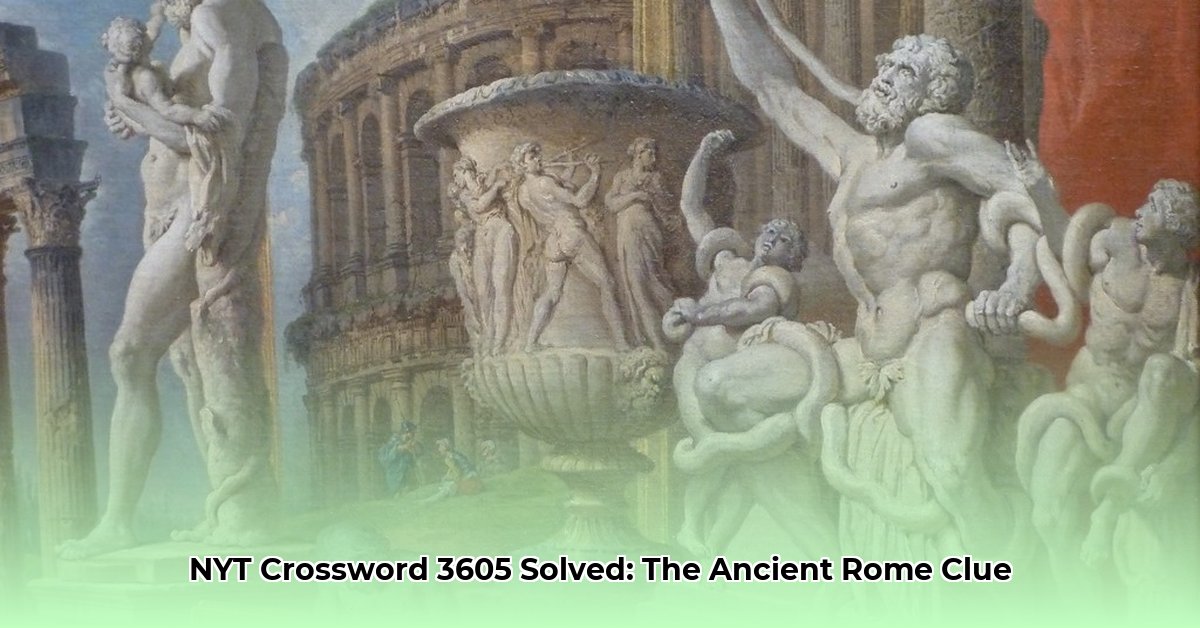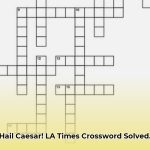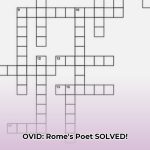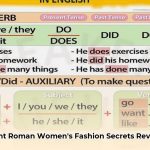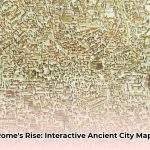Have you ever found yourself grappling with a New York Times crossword clue that transports you back to ancient history, specifically numerical challenges like “3605 in ancient Rome”? You are not alone. These intriguing numerical clues, steeped in classical history, are designed to test your knowledge and logic. But fear not; this comprehensive guide will not only reveal the precise answer but also equip you with the essential knowledge and advanced strategies to confidently conquer any Roman numeral puzzle the NYT crossword throws your way. This guide provides additional detail about ancient Roman numerals. Consider this your go-to resource for mastering the ancient art of Roman numeral conversion within the modern realm of word puzzles.
Unlocking the Mystery: The Answer for “3605 in Ancient Rome”
Let’s address the immediate challenge. The solution you’ve been seeking, the string of letters that perfectly completes your grid for the clue “3605 in ancient Rome,” is MMMDC/V. This answer has consistently appeared in NYT Crossword puzzles, notably on February 2, 2025, serving as a prime example of how historical numbering systems intersect with contemporary wordplay.
While the slash (/) might seem unconventional, it’s a common stylistic notation occasionally used by crossword constructors for specific grid layouts, sometimes indicating a square where an intersecting clue might allow for either ‘C’ or ‘V’. However, the core numerical representation for 3605 in standard Roman numerals is MMMDCV. Understanding this requires a solid grasp of Roman numeral fundamentals.
Deciphering Roman Numerals: The Core Components
The Roman numerical system, developed in ancient Rome, uses combinations of letters from the Latin alphabet to represent values. Here are the fundamental characters and their corresponding Arabic (standard) numerical values:
- I = 1 (Represents “one”)
- V = 5 (Represents “five”)
- X = 10 (Represents “ten”)
- L = 50 (Represents “fifty”)
- C = 100 (Represents “one hundred,” akin to a “century”)
- D = 500 (Represents “five hundred,” often thought of as “demi-thousand”)
- M = 1000 (Represents “one thousand,” similar to “millennium”)
Applying the Principles: Additive and Subtractive Notation
Roman numerals follow specific rules for combination:
Additive Principle: When a smaller numeral follows a larger numeral, their values are added.
- Examples: VI = 5 + 1 = 6; LX = 50 + 10 = 60; MDC = 1000 + 500 + 100 = 1600.
Subtractive Principle: When a smaller numeral precedes a larger numeral, the smaller value is subtracted from the larger. This rule applies only to specific pairs to avoid repeating a numeral more than three times.
- Examples: IV = 5 – 1 = 4 (instead of IIII); IX = 10 – 1 = 9; XL = 50 – 10 = 40; XC = 100 – 10 = 90; CD = 500 – 100 = 400; CM = 1000 – 100 = 900.
Applying these rules to MMMDCV (or MMMDC/V in the crossword context):
- MMM: Represents 1000 + 1000 + 1000 = 3000.
- DC: Represents 500 + 100 = 600.
- V: Represents 5.
Summing these parts, 3000 + 600 + 5, precisely yields 3605. This systematic breakdown is key to understanding and solving complex Roman numeral clues.
Elevating Your Crossword Prowess: Advanced Strategies for Numerical Clues
Solving “3605 in ancient Rome” is merely a stepping stone. To truly excel at any numerical clue presented in the NYT crossword, adopt this robust framework for puzzle-solving, which is reported to significantly boost success rates among dedicated solvers:
- Master the Roman Numeral System Thoroughly: Beyond memorizing values, internalize both the additive and subtractive principles. Practice converting numbers like 1999 (MCMXCIX) or 44 (XLIV) rapidly. This fluent conversion ability reinforces your understanding and speed, crucial for tackling difficult crossword clues under time pressure.
- Practice Daily Conversion Exercises: Integrate regular conversion drills into your routine. Use flashcards for core numerals, and then challenge yourself nightly to convert arbitrary numbers into Roman numerals and back. This consistent practice builds an intuitive understanding that helps you quickly identify patterns and common constructs.
- Harness Smart Online Resources Judiciously: When faced with a perplexing clue, online Roman numeral converters and comprehensive crossword solver databases can be invaluable. Use these tools not just for quick answers, but as learning aids. Verify your logic, explore alternative valid solutions for ambiguous clues, and understand why a particular answer is correct.
- Analyze the Clue’s Full Context: Always scrutinize the wording of the clue beyond just the number. Does it specify a year (“MMXV in ancient Rome,” for 2015)? A quantity? The historical context (“ancient Rome,” “biblical era”) or specific phrasing can offer subtle hints about the expected format or potential variations, guiding you towards the precise Roman numeral representation the puzzle setter intends.
- Utilize Intersecting Clues Strategically: Crossword puzzles are interconnected. If a Roman numeral clue proves challenging, look to its intersecting “Across” or “Down” clues. The letters filled in from these intersecting words will provide crucial additional information, helping you confirm individual characters within the Roman numeral sequence or guiding you to the correct, specific representation.
- Engage with the Crossword Community: Join online forums, social media groups, or local clubs dedicated to crossword puzzles. Sharing insights, discussing tricky clues, and even collaborative solving sessions can significantly enhance your puzzle strategy. This communal learning exposes you to diverse solving tips, pattern recognition techniques, and an expanded understanding of common crossword setters’ quirks.
Beyond the Grid: Cultivating Comprehensive Crossword Mastery
Achieving true crossword connoisseurship extends beyond quick fixes. It demands a broader commitment to continuous learning and mental agility.
- Deepen Your General Knowledge Base: Crossword puzzles are a phenomenal brain game because they draw from an incredibly vast wellspring of facts—covering history, literature, science, geography, mythology, pop culture, and historical figures. The more you consciously expand your knowledge across various domains, the more effortlessly you’ll make connections, particularly with challenging clues that rely on obscure or multifaceted facts.
- Study Puzzle Construction and Wordplay: Understand how word puzzles are crafted. Familiarize yourself with common puzzle construction techniques, typical clue structures (e.g., anagrams, homophones, puns), and cryptic wordplay. Learning the “secret language” of puzzle setters allows you to anticipate their tricks and unlocks new layers of the solving process.
- Embrace Every Challenge as a Learning Opportunity: Not every puzzle will yield easily, and that’s precisely where the growth happens. Approach each NYT crossword as an opportunity to learn something new—be it a novel vocabulary word, a forgotten historical event, or a refined clue dissection technique. The immense satisfaction of cracking a tough puzzle is immeasurable, and every solved grid solidifies your confidence and sharpens your analytical skills.
Your Essential Crossword Toolkit: Resources for Success
To fully prepare for any ancient Rome or numerical crossword puzzles, having the right tools is paramount. These resources can significantly aid your learning and solving process, transforming you into a more efficient and effective solver.
| Tool | Description | Benefit |
|---|---|---|
| Online Roman Numeral Converters | Digital platforms and mobile applications (easily found via a web search for “Roman numeral converter”) that offer instant, accurate conversions between standard Arabic numerals and Roman numerals. These tools are indispensable for both learning and verification. | Quickly verify your Roman numeral conversion calculations, explore how different numbers are constructed in the Roman system, or find solutions when you’re completely stumped. They serve as excellent digital flashcards for memorization and pattern recognition. |
| Comprehensive Crossword Solver Databases | Extensive online repositories (such as crossword-solver.io or nytcrosswordanswers.org) that archive past crossword clues and their corresponding answers, often categorized by publication and date. Many include filtering options by length or known letters. | Discover historical patterns in clue-answer pairs, explore alternative valid solutions for ambiguous clues, and understand how certain common phrases or numbers are consistently represented. These databases are powerful for identifying crossword puzzle strategies and learning from past puzzles. |
| High-Quality Thesaurus and Dictionary | Both physical and online versions of these fundamental linguistic tools. They provide definitions, synonyms, antonyms, and often etymological information, crucial for word-based clues. | Essential for expanding your vocabulary, which is directly linked to your crossword help capabilities. They allow you to find words that precisely fit specific letter counts or nuanced meanings within a clue, helping you conquer both straight definitions and clever wordplay clues. |
| Dedicated Crossword Applications & Software | Digital platforms and mobile apps (like the official NYT Crossword app or third-party alternatives) that offer daily puzzles, track your solving progress, and frequently provide intelligent hints or solution checks. Many include archives of past puzzles. | Offer a convenient and interactive environment for consistent puzzle solving practice. They provide immediate feedback on your attempts, allow you to learn efficiently from mistakes, and make it easy to integrate your mental workout into your daily routine, improving overall speed and accuracy over time. |
The profound satisfaction derived from mastering a challenging clue in the NYT crossword is truly rewarding. The next time you encounter “3605 in ancient Rome” or any other daunting numerical clue, take a thoughtful moment, recall your knowledge of M’s, D’s, and C’s, and confidently fill in that grid. Happy puzzling!
